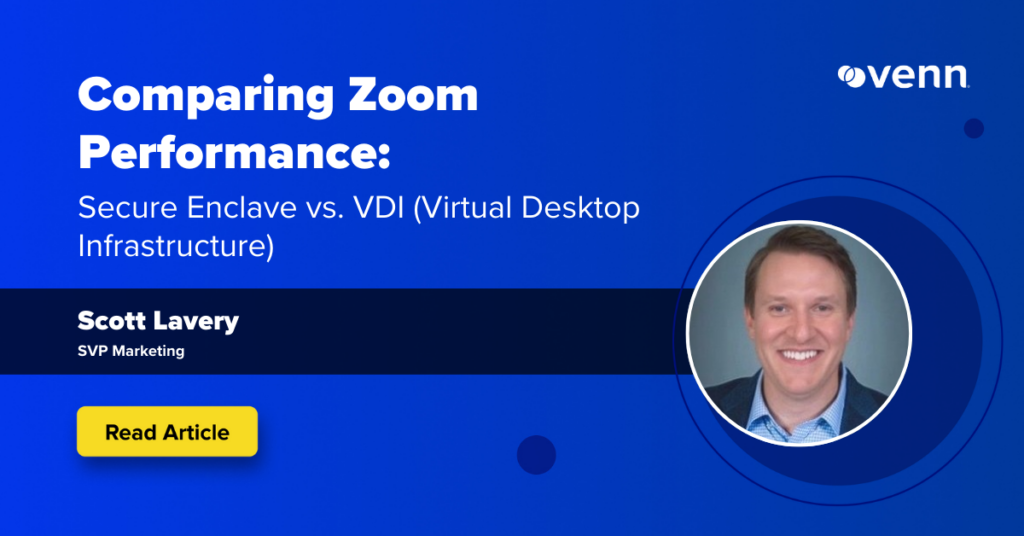In today’s world of remote work, Zoom has become an indispensable tool for virtual meetings, team collaboration, and real-time communication. But for organizations that are currently utilizing (or scoping) Virtual Desktop Infrastructure (VDI) to address security and compliance for BYOD and remote users, a crucial question arises:
What’s the difference in Zoom performance when running through a virtual desktop vs. running it natively on your local machine while utilizing Secure Enclave technology?
The answer lies in latency — the time delay between when you speak or act and when the other participants experience it. Understanding these differences is essential for businesses balancing security, performance, and user experience in remote work environments.
Native (Secure Enclave) Zoom Client: The Gold Standard for Low Latency
When you run Zoom directly on your local machine, you’re getting the best possible performance. Here’s why:
- Direct Connection: The native Zoom client connects directly to Zoom’s cloud servers, minimizing the number of network hops.
- Local Processing: Your device handles audio and video processing, taking advantage of your hardware’s CPU and GPU capabilities.
- Minimal Latency: With no intermediary systems, latency is typically in the range of 100-150 millisecond — low enough to feel natural and seamless during conversations.
Key Advantages of Native Zoom:
- Lowest possible latency
- High video and audio quality
- Full use of local device resources
Natively (and securely) running Zoom on a BYOD computer is made possible by Secure Enclave technology. Similar to an MDM solution but for laptops, work lives in the company-controlled container installed on the user’s PC or Mac, where all data is encrypted, and access is managed. Work applications run locally within the Enclave, protecting and isolating business activity from any personal use on the same computer. Company data is secured without controlling the entire device, all while ensuring end-user privacy.
Zoom Through Virtual Desktop: The Secure, But Slower Option
Running Zoom through a Virtual Desktop Infrastructure (VDI) adds an additional layer of security, but it comes with a performance cost. In a VDI setup, your device connects to a virtual desktop hosted on a remote server, and Zoom runs inside that virtual environment.
Why VDI Adds Latency:
- Network Routing: Instead of connecting directly to Zoom servers, your audio and video streams need to route through the virtual desktop first.
- Processing Delays: The virtual desktop handles audio and video processing, which can introduce delays if the VDI server is overloaded or geographically distant.
- Shared Resources: In multi-user VDI environments, resource contention can further slow down performance.
The result? Typical latency for Zoom through VDI is around 200-300 milliseconds — noticeably higher than running Zoom natively. In some cases, latency can exceed 300 milliseconds, leading to frustrating delays and awkward interruptions in meetings.
Key Challenges of Zoom via VDI:
- Higher latency (200-300+ milliseconds)
- Potential video and audio quality degradation
- Dependent on VDI server performance
Latency Comparison: Native Zoom vs. Virtual Desktop
| Factor | Zoom via Secure Enclave | Zoom via Virtual Desktop (VDI) |
| Latency Range | 100-150 milliseconds | 200-300+ milliseconds |
| Audio/Video Processing | Local machine | VDI server (or local if offloaded) |
| Network Hops | Direct to Zoom servers | Through VDI server first |
| Video Quality | High | Dependent on VDI solution |
| Security | Less secure in BYOD setups | More secure for BYOD environments |
What This Means for BYOD Security and Performance
For companies that prioritize secure BYOD setups (ex. finance, healthcare, or business process outsourcing), VDI can provide a secure environment for Zoom. But the higher latency can negatively impact user experience.
Companies like Venn are taking a different approach to solving the BYOD security vs. performance dilemma. Instead of forcing all applications to run inside a virtual desktop, solutions like Secure Enclaves technology allow users to run native Zoom clients with company-managed, policy-based security controls being enforced on BYOD computers. This approach delivers the best of both worlds:
- Native performance for Zoom
- Enhanced security to protect sensitive company data
The Bottom Line: Choosing the Right Security Setup for Your Zoom Instance
The choice between running Zoom through a virtual desktop or natively via Secure Enclave technology comes down to balancing security and performance. Here’s a quick guide to help you decide:
- Choose Native (Secure Enclave) Zoom if:
- Your workforce consists of contractors or third-party partners.
- Your workforce uses personal, unmanaged, or third-party managed devices (BYOD.)
- Data security is a top priority
- You prioritize real-time collaboration with minimal latency.
- You want the highest video and audio quality.
- Choose Zoom via VDI if:
- Your workforce consists of only on-site employees
- Your workforces exclusively uses managed devices
- Data security is not a top priority.
Final Thoughts: Don’t Let VDI Latency Kill Your Zoom Meetings
As remote work continues to evolve, companies must carefully consider how they balance performance and security. Zoom meetings are too important to let latency and poor user experience ruin productivity. By understanding the differences between Secure Enclave technology and VDI Zoom setups, and leveraging modern solutions like Venn: The Secure Enclave Built for Enterprise, businesses can empower their remote workforce to stay connected without compromise.
Want to learn more about secure BYOD solutions that don’t sacrifice performance? Request a Demo of Venn today.



